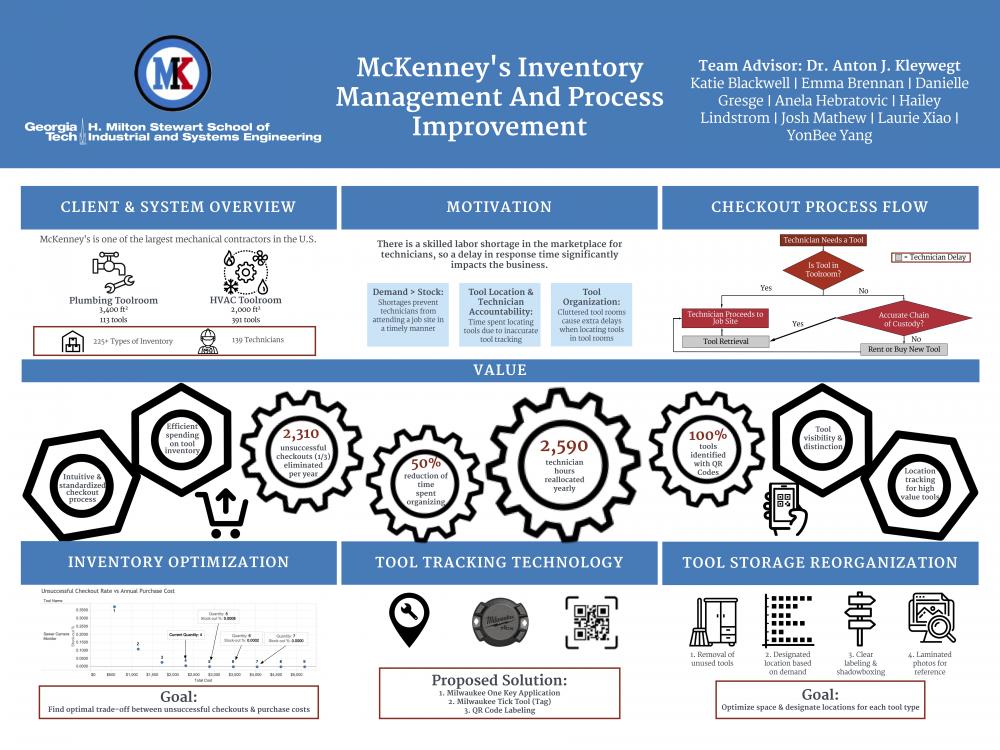Client Context
McKenney’s, Inc. is a privately owned mechanical service provider offering services in facility construction, operations, and maintenance across each stage of a building’s life cycle. The focus of this project includes two tool rooms on McKenney’s main campus in Atlanta: a plumbing toolroom and a heating, ventilation, and air conditioning (HVAC) toolroom. Both rooms hold specialty equipment regularly used by 139 McKenney’s skilled technicians to complete their jobs. 113 individual tools are stored in the 3,400 ft2 plumbing room, and 391 tools are stored in the 2,000 ft2 HVAC room. Together, these tools make up over 225 different tool types.
To access either of the tool rooms, a technician must first check out a key from the dispatch office before driving to the respective toolroom to retrieve a tool, a process which takes an average of 14 minutes. The key retrieval process was set in place as an attempt to keep technicians accountable for tool checkouts. Once the technician enters the toolroom, they open up an in-house web-based application called ToolConnect Lite on their mobile device. This app is used to check in and check out the tools and is intended to show technicians whether or not a tool is available in the toolroom or checked out by another technician. To check a tool in or out, a technician must look up a tool by typing in the last four-digits of the serial number from the tool’s barcode sticker. However, only some of the tools are identified with a barcode, so if a tool does not have one, then there is no procedure for checking it in or out. Only about 25% of checkouts are recorded in the app, so the app does not accurately reflect each tool’s availability or chain of custody.
Project Objective
McKenney's technicians regularly check out specialty tools in the plumbing and HVAC tool rooms to complete their service calls. Response time to service calls is a critical factor for McKenney's service level, so they emphasize the importance of reducing response time. Technicians spend a significant amount of time looking for tools they expect to be in the toolroom, but the tools are ultimately not there. This absence is due to: tool demand exceeding supply, no standardized system for tracking tool check-ins and checkouts, and no formal organization in place for tool storage.
To reduce the time technicians spend looking or waiting for tools, this project focuses on helping McKenney’s determine the appropriate number of tools to have in inventory, while increasing technician accountability and improving tool visibility and organization. To minimize the cost of having the appropriate number of tools, an inventory optimization model generates the optimal number of each tool type to keep in inventory. To standardize the checkout process and increase technician accountability, a cost-benefit analysis highlights the various tool tracking technologies that could be implemented. Lastly, to improve tool visibility, the storage reorganization ensures a designated location and labeling method for each tool type.
Design Strategy
Inventory Optimization: The methodology for the inventory optimization was to create a simulation that could take in existing information about a tool type and output the total cost and percentage of time a technician enters the toolroom and is unable to checkout a tool he needs. The first step was to collect and analyze data on the checkout frequency and duration of a tool. The next step was to create a Monte Carlo simulation that could use this data to test various quantities above and below the current inventory level to compare alternative tool quantity scenarios.
Tool Tracking Cost-Benefit Analysis: The methodology for this analysis was to find a tool tracking technology or a combination of technologies for McKenney’s to implement to standardize the checkout process and increase technician accountability. The first step was to explore various tool tracking technologies and research each one’s benefits and drawbacks. The next step was to review the findings with the client and validate which technologies were feasible and most applicable to them.
Tool Storage Reorganization: The approach for this reorganization was to improve tool visibility. The storage reorganization would ensure a designated location and labeling method for each tool type. The first step for this deliverable was to remove any tool unrelated to the specialty work McKenney’s technicians perform and reuse the space as consolidated storage space for specific tool types. The next step was to designate tool locations based on demand, so tool types used more often are situated closer to the entrance for quicker access. The third step was to label for tools on the shelves or create shadow boxes for larger equipment that have to be situated on the floor to denote different tool types. The last step was to create laminated images of the shelves and shadow boxes for technicians to easily reference to maintain this organization.
Deliverables
Inventory Optimization: This deliverable helps McKenney’s determine the appropriate number of tools to have in inventory. Additionally, this deliverable can potentially decrease the amount of time that tool demand is greater than the current inventory level.
Tool Tracking Cost-Benefit Analysis: An analysis was conducted on various tool tracking technologies which included the benefits, drawbacks and costs of each technology. McKenney’s now has the information on what to purchase and how to implement the technology. This deliverable helps standardize the check-in/check-out process and keep technicians accountable for their tools.
Tool Storage Reorganization: There is now clear visibility and formal organization of the toolroom. This reorganization is expected to withstand changes in inventory level and industry growth. Technicians will now be able to quickly find the tools they need for a client once they enter the toolroom.


